By Molly Haskell in the March-April 2008 Issue
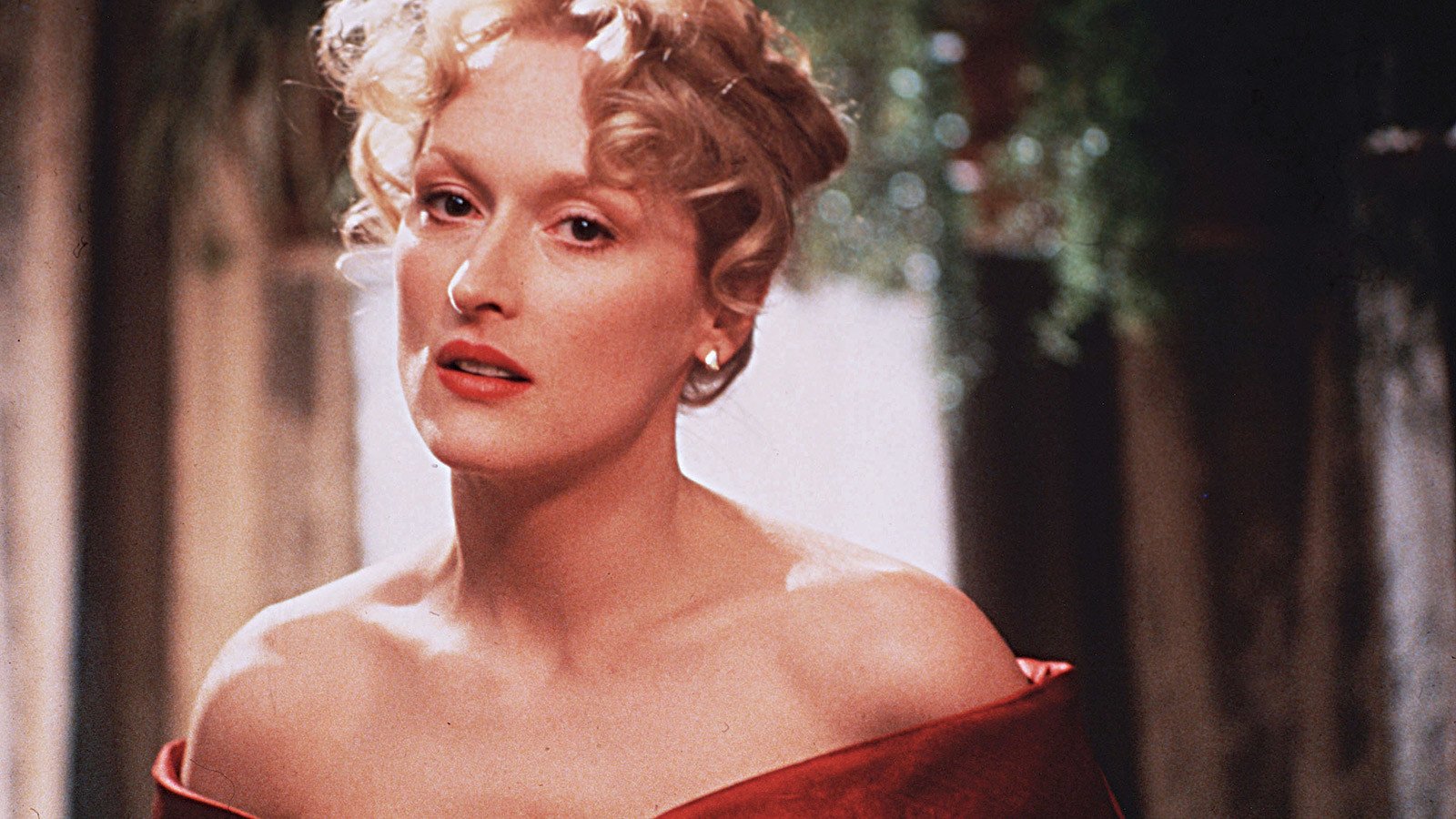
Finding Herself
The everlasting prime of an acting powerhouse who gracefully eludes definition yet is every inch a star
After years of respecting the work of Meryl Streep, what was it that made audiences suddenly fall in love with her in The Devil Wears Prada? It’s not that we ever took her for granted—14 Oscar nominations and two wins in 28 years would hardly indicate that—but there’s a different kind of excitement about Streep, now in her late fifties, that wasn't there before. The 2006 fashionista “flattire” is inconsequential as comedy, and schizophrenic as satire; and Miranda Priestly is a role that Streep could do in her sleep. But when she’s on screen it's such outrageous fun that the actress and her career are cast in a new light.
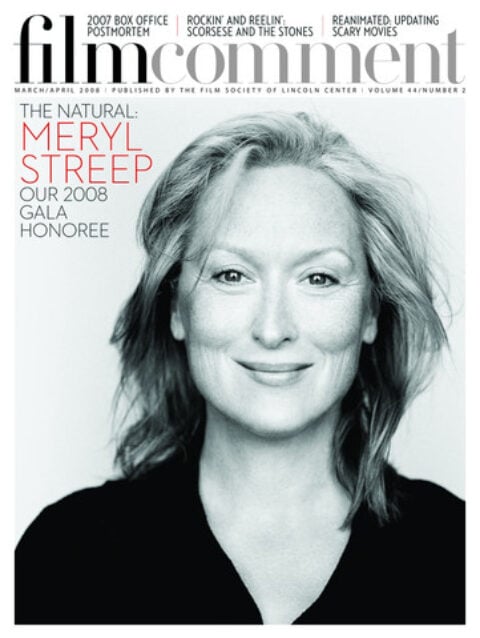
From the March-April 2008 Issue
Also in this issue
She’s proving now, in the freedom and prosperity of a spectacularly attractive late middle age, that she can do effortless as well as strenuous, ensemble as well as star, enjoy rather than hide behind her talent. More than that, it’s as if audiences who’d been lulled into a catatonia of admiration or vexation were forced to wake up and take notice of the dazzling dexterity and audacity of this woman who’s amassed a body of work that’s phenomenal any way you look at it, but especially at a time and in a filmmaking climate tyrannized by the male adolescent demographic. From 1977 to 2007, three decades in which a Hollywood was busy merchandising global franchises and blockbusters and independent cinema was proving its cojones, Meryl Streep made 44 mostly high profile films. And, to borrow the anthem of Shirley MacLaine who plays her mother in Postcards from the Edge (90), “she’s still here”—not just here, but on her own terms, not Hollywood’s.
She’s looser now; the body and mind seem to be working together, enjoying each other. She can give vent to the inner cut-up, the chantoozie, supporting actress, play with her own image without resorting to parody. Even the formulaic morality-tale aspect of The Devil Wears Prada allows her to slide into dragon-lady archetype without reinventing the wheel. Think urban western with Miranda as a woman-in-furs version of Javier Bardem’s roving monster of malignancy in No Country for Old Men, and the offices of Runway magazine as the town silent and trembling before the arrival of the evil dominatrix. She rides the elevator alone (how else? Who would dare ride with her?), casting off her fur as she emerges (everyone outside is in summer clothes), summoning her quaking courtiers, leveling mere mortals with a single blow, the funereally whispered phrase “That’s all.”
The Devil Wears Prada
Pauline Kael, never a fan, wrote cruelly if not inaccurately after Sophie’s Choice (82) that she acted only from the neck up, that by focusing everything on an accent or a toss of the head, she in effect decorporealized herself. In the first place, that’s not entirely true, certainly not lately. As Miranda she’s at one with her body. It would be hard not to remember the image of her presiding over the Metropolitan Museum gala, attired in black décolleté down to her navel, her alabaster skin gleaming like jewels, and on either side, her two spear-carrier girl gofers utterly annihilated by the majesty of that belle poitrine! And to the extent she does deflect attention from the body to the head, it’s not just in the interest of accents, hair, gimmicks: it’s because the lady thinks. Her characters can have more than one idea in their heads at a time. Her off-center looks have always been part of the puzzle: is she beautiful or is she strikingly plain? What does she think? And how do people react to that milky, man-in-the-moon face, round and flat in certain lights and, in others, full of shadows and contours. Does she obscure her “beauty” in order to be taken seriously or are her disguises distractions from what she perceives as a lack of beauty? Occasionally her elaborate evasions and transformations seem examples of what’s known as the Helen Hayes syndrome, in which an actress compensates for an inferiority complex about her appearance by a more strenuous acting style. There’s such a thing, said a friend of mine when A Cry in the Dark (88) came out, as the willful destruction of one’s looks. Yet her Lindy Chamberlain didn’t just perfectly resemble the real Lindy; her spooky looks—the helmet of black hair, the darting-up eyebrows—contributed to a vital sense of alienation between character and audience, mimicking the chilling reserve of the woman who was convicted of murder because the Australian public simply couldn’t stand her.
As a powerful and inevitably self-reliant career woman, she might be able to say, like Miranda Priestly when saddled with a Page Six scandal: “I don’t care what they write about me.” The line, however tinged with bravado, nevertheless asserts a liberation from the need to please, in Streep’s case to be free of the need to prove herself or comply with the narrow romantic expectations and definitions of women that has been part of her make-up from the beginning.
Everything has come together in an uncanny way, as if this was the moment she was always reaching for. And perhaps it was: take a look at the home movies that opened the 2004 AFI Tribute, and as you watch the little girl in glasses prancing around her family’s suburban backyard while Streep explains that she loved to dress up as an older women, and imagine being her mother and grandmother, you realize that the prematurely aged diva of Summit, New Jersey has been rehearsing for this time in her life for years.
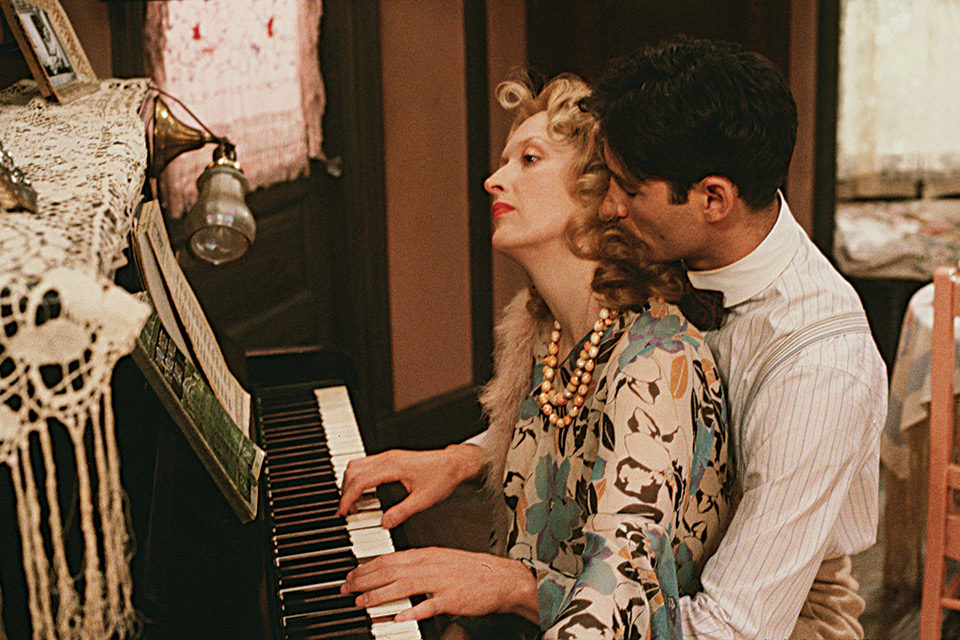
Sophie's Choice
That little girl decided one day not to wear her spectacles, and a few years later, tired of not being beautiful, discovered peroxide and soon thereafter was elected Homecoming Queen. She knew even then how to manage her career, and how to do blonde bombshell, a role she burnished to caricature perfection as the platinum blonde best-selling husband-stealing romance novelist in She-Devil (89) and again in Death Becomes Her (92), Robert Zemeckis’s comedy about aging Hollywood stars.
There’s a line in the movie of David Hare’s Plenty when Streep’s Susan Traherne, now in advertising, is watching a photo shoot with her boss, and he turns to her and says of the model: “I wish she were more ordinary looking. Will audiences identify?” Since we never see the woman, and the line isn’t in the play, we can only assume Hare wrote it about Streep. This was in 1985, after small parts in Julia, The Deer Hunter, Manhattan, second leads in The Seduction of Joe Tynan and Kramer vs. Kramer, and starring roles in The French Lieutenant’s Woman, Sophie’s Choice, Silkwood, and Falling in Love, an assortment of popular and critical successes and failures. Critical reaction had run the gamut from rapturous (she can do anything!) to savage (too technical, an acting machine, a robot, an android!), to the double-edged (she’s different in every film), from hyperbole to backlash. Apparently (at least in Hare’s eyes) the jury was still out as to whether Hollywood stardom was in the cards for an actress who was determined to do idiosyncratic, theatrical roles in a medium in which success—as in advertising, less so in theater—depends on being loved by huge numbers of people and convincing them that, however unusual or exotic, she’s linked to them in some profound emotional way.
It’s not so much about being “ordinary”—or even about being glamorous (Bette Davis wasn’t; many stars aren’t)—but rather about a continuous relationship to the audience, a staying in one place, a kind of one-on-one intensity, playing a version of oneself . . . or a close relative.
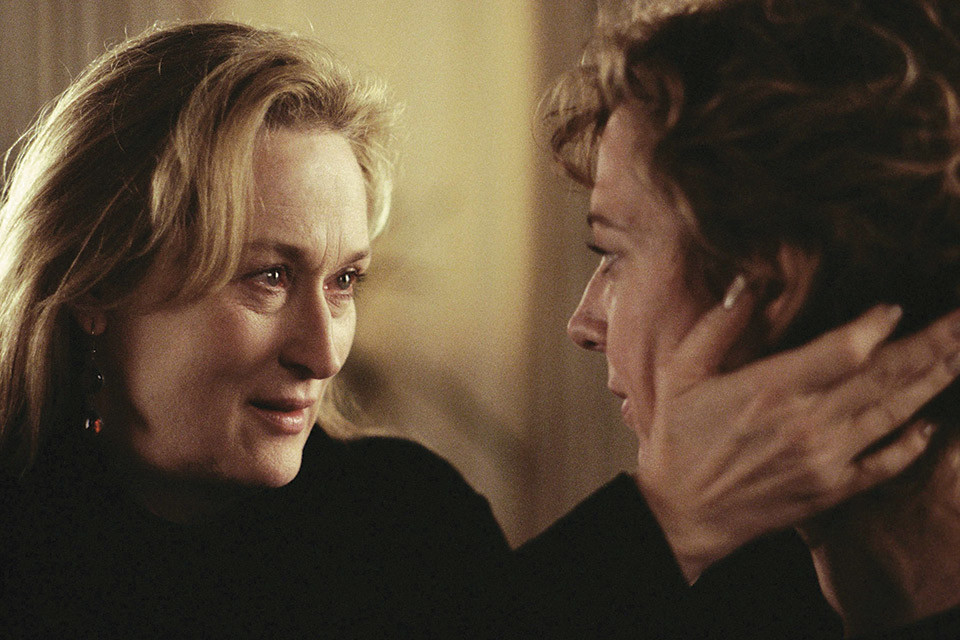
The Hours
In her willingness to forego easy identification, she upholds a venerable Hollywood article of faith, namely that Real Acting involves twisting oneself out of shape, preferably with the help of putty wigs, limps, accents, and other disguises, even extra poundage, the latest stunt of star self-mortification in an anorexia-worshipping culture. It looks brave and bold and gets Oscars, which is why Streep won her Best Actress Award for the relentlessly fidgety, mercurial, flirty-prevaricating Sophie of the adorably-Polish-inflected English, and Kidman hers for playing a putty-nosed Virginia Woolf in The Hours (02), a film in which Streep, at her most unadorned and passionately direct, turned in far the superior performance.
However varied the performances of studio stars like Davis, say, or Hepburn or Stanwyck, we always felt we were in the presence of something knowable, familiar, constant. They had recognizable voices, ways of reading a line, even certain expressions that remained consistent from film to film, and audiences went to a Bette Davis or Joan Crawford movie knowing what they would get. Comics could do imitations of them, they became the objects of parody (sometimes self-parody in later life), and you either responded to their personae or you didn’t. Streep never stayed in one place long enough for anyone to get a fix on her, or to form that kind of fanatical relationship. Even the later stars, Streep’s contemporaries, though not formed and nurtured by the studios, have core personalities, a kind of transparent identity around which signature adjectives cluster: Diane Keaton and Sally Field (girlish, engaging, all-American), Jessica Lange (sexy, fragile), Glenn Close (icy, a touch of malignancy). Julianne Moore, sensual and breakable. Susan Sarandon, though a bit less of a “type,” is wise and womanly even when she plays slatternly. Even that goddess of the theater Vanessa Redgrave has something we feel we know, a ferocity and a tendency to sacrifice intellect to passion. And Nicole Kidman, most chameleon-like of her generation, has a cool ironic playfulness, and enough sex appeal to inspire mash notes, including a whole mash book by the critic and connoisseur David Thomson. This close-up and personal sense of familiarity may be an illusion, and a slightly insane one at that, but it is integral to our movie-going fantasies, to the unconscious transaction whereby they become extensions of ourselves; our knowledge and forgiveness allows them to go out on a limb and still retain our sympathy.
But Streep? Who knows. There’s no set of predictable characteristics. Think of her contemporaries on a talk show. Keaton would be ditzy, Sally Field bubbly, Nicole Kidman coolly yet chattily Australian. But when you see Meryl Streep on, say, Charlie Rose or Ellen, you don’t see a “personality” but a witty thinking woman. Catch her on Ellen, exchanging borough accents, and promoting Prime (05), in which she plays a Jewish Upper West Side shrink (wonderfully!) to a shiksa patient (Uma Thurman) in love with a much younger man who happens to be—as Streep’s character slowly and hilariously grasps—her own son. This brings to the fore a furious conflict between the rabid faith-based objections of a Jewish-mother, and the “follow your bliss” philosophy the “tolerant” therapist imparts to her hip clientele. The script, as Streep recounted on Ellen, was pitched to her as the story of love between an older woman and a younger man. She smiled in happy anticipation, only to find out that she wasn’t the “older woman,” but the “older older woman.” It’s very funny, a moment that points up the absurdity of an age system that sees Uma Thurman as an “older woman,” and Streep can enjoy it as much as anybody.
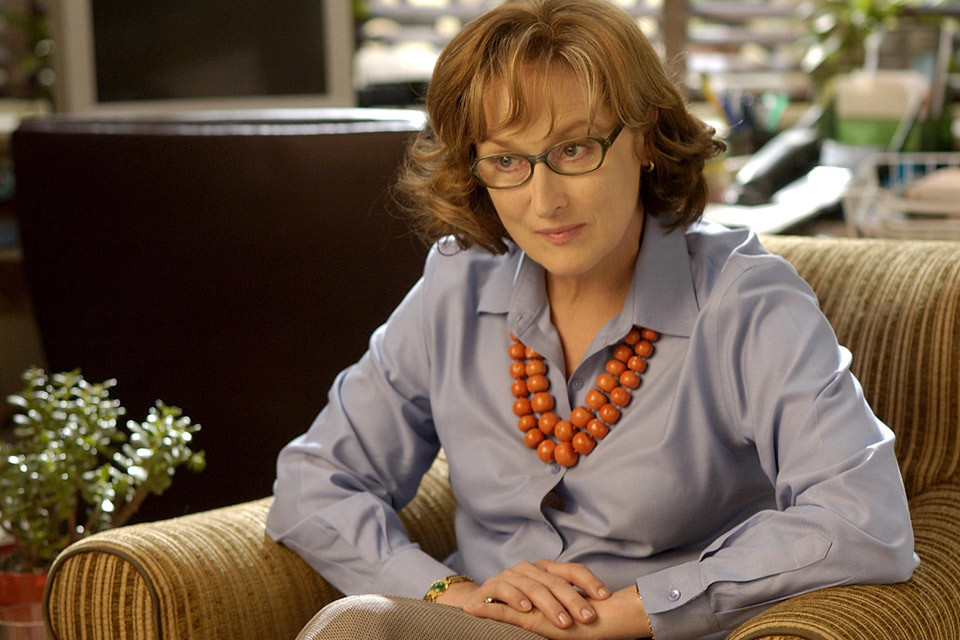
Prime
The irony is that all those characteristics once considered limitations, the lack of “sex appeal,” the over-calculation, seem now to have been working in her favor. The sexy ones get used up, the hotties flame out. Sex appeal is almost as fragile, for a female star, as a one-night stand. Audiences are more fickle where women are concerned, want ever newer, fresher flesh. Streep’s had plenty of sexy movies (more of that anon), but she hasn’t defined herself as a babe—perhaps for the reasons cited above, that ambivalence about her looks. And so she’s had no glamour-puss image to compete with, no earlier pin-up stalking and overshadowing her present self.
Then take the “she’s too actress-y” rap. It’s not that the terrorist-editor of Runway, or the thigh-slapping country singer in A Prairie Home Companion (06) is less actress-y, but that actressiness itself has become for Streep essence as well as armor. It’s who she is, and who she is is an acknowledgement—stylish, stylized, and ongoing—that women are always playing roles. And that women, women with any brains at all, are invariably divided. This is the dilemma she seems to know deep in her bones. And that, in being divided, no fulfillment can be permanent, peak experiences are few and far between, sadness and loss are inevitable.
Even when not overtly feminist, her films of the late Seventies and Eighties are very much hooked into the American cinema’s ongoing struggle to sort out its ideas and feelings about modern womanhood. Nor was Streep alone in this. Though the period didn’t seem particularly propitious to actresses at the time, it looks like a golden age compared to the great dumbing down of the last 20 years. It was a time when Sissy Spacek, Barbara Hershey, Sigourney Weaver, Sally Field, and Jane Fonda played whistle-blowers, union organizers, anthropologists, hookers, and writers with raised consciousnesses, in movies of substance that would never get past a story conference today.
Manhattan
Streep’s refusal to ask for sympathy established itself early on—in her first role, a walk-on in Julia (77). As a strikingly pretty New York sophisticate and right-wing dilettante, she was everything her friend Lillian Hellman, now headed for Russia, was determined not to be (“You look so very slim, Lillian; Russia, of all places!”). She was the sullen, funny ex-wife turned lesbian in Woody Allen’s Manhattan (78); as the Southern lawyer and liberal politico in The Seduction of Joe Tynan (79), she’s the Other Woman who competes for the affections of liberal senator Alan Alda with his wife, the ultra-lovable Barbara Harris.
As the ex-wife writing a tell-all memoir in Manhattan, and as Joanna in Kramer vs. Kramer (79), both films landing as the women’s movement was causing a seismic shift in the cultural landscape, she’s every husband’s fear of “women’s lib” and the nefarious reach of the consciousness-raising session. Were Joanna Kramer and her buddy-neighbor (Jane Alexander) cooking up a rebellion in the co-op laundry room? Joanna walks out on work-obsessed ad exec husband (Dustin Hoffman) and angelic kid (Justin Henry) to “find herself.” “I was always somebody’s wife, mother, daughter, I never knew who I was…” These became the buzzwords of liberation, and perhaps they weren’t terribly original at the time, but their very vagueness and the sense of hopelessness generated by Streep’s wanly depressive Joanna, who doesn’t yet have a self to defend, suggest the void opening up, the terror of a woman leaving the shore of secure, prefabricated roles and into the deep waters of who knew what? It was a time when a lawyer could make his case and reduce a discontented woman to absurdity in the eyes of the world by asking rhetorically Did you husband beat you? Did he drink? Play around? Fail to support you? If the answer to these was “no,” then what in the world did the selfish bitch have to gripe about!
In the long monologue of her courtroom scene, she confesses to the terrible sense of inadequacy that caused her to leave her husband and child, and describes her gradual laborious emergence as “a whole human being.” “I don’t think I should be punished for that,” she concludes. “I’m his mother, I’m his mother.” What emerges is spellbinding in its own muted way: Joanna—shades of Lindy Chamberlain to come—never raises her voice, shows little emotion beyond a onetime catch in the throat, a brief glisten in the eye—while Hoffman acts up a storm, bragging about his newfound parenting skills, gesticulating, emoting, aiming straight for the audiences’ heart. Indeed, audiences dissolve at the spectacle of a grown man softening, while, in a converse reflex, we automatically cringe at the sight of a determined or emotionally opaque woman, which is read as hard and unfeminine. It simply hits too close to the primal bone, to the never-forgiven (though repressed and not forgotten) image of the powerful mother of the nursery.
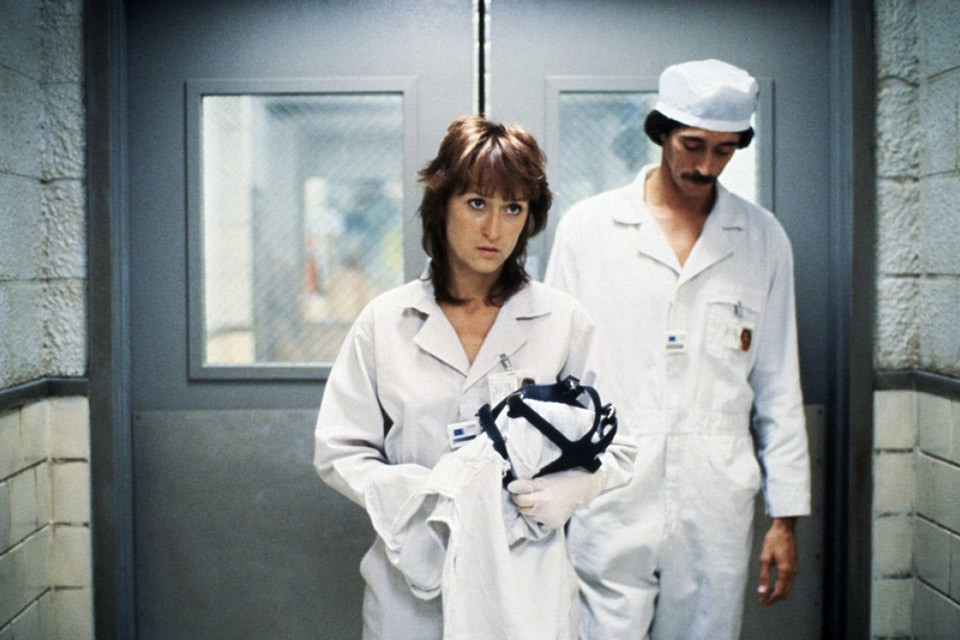
Silkwood
Unchastened, Streep continued to play “difficult” women, two of the greatest being Silkwood (83) and A Cry in the Dark. Neither is explicitly feminist but both raise issues that are as fundamental to feminism and gender awareness as you can get, like how much narrower the latitude of acceptable behavior is for women than for men; how quickly women are penalized for straying from the feminine (and maternal) ideal.
“You’re two different people,” her boyfriend Kurt Russell says to her in Silkwood, and one of them’s “the biggest bitch God ever made.” Indeed, gum-chewing, nosy, blunt-talking Karen Silkwood earns the enmity of just about everyone when she blows the cover on the dangers of the uranium processing plant where she works, and even makes life difficult for her supposed allies in the union. That’s before she screws herself through her own inability to get along and go along. Streep gets miraculously into the skin of this good ole country gal for whom the word feminism would have little meaning—the kind of girl who took chemistry rather than home ec only because that’s where the boys were. At the same time, she’s fearless, an impolitic pain-in-the-ass fighter once she gets a cause under her belt. She can be as abrasive as the alarms that go off when someone’s “cooked.” Yet there are wonderfully tender moments—loving ones with Russell and with Cher as her lesbian best friend, and an immensely moving short monologue about her mother. The actress, working joyfully in her first film under Mike Nichols’s direction, gives us all of Karen’s sides, and when this tough broad goes down, under the strands of Streep’s heartbreakingly pure rendition of “Amazing Grace,” we feel the tragedy more deeply than if she’d merely been a goody two-shoes with an open-and-shut cause.
Likewise her Lindy Chamberlain (“the dingo ayte my bayby”) is no feminist, but a provincial Seventh Day Adventist married to a pastor (Sam Neill), and their religion, seen as a cult, is one of the first strikes against them when the baby disappears. If the couple acts with the resignation of believers to the tragedy, the public accuses them of making a human sacrifice. If she blames the dingo, describing what it can do to a body in chillingly graphic terms, she’s further demonized, by animal lovers on the one hand and woman-haters on the other. Director Fred Schepisi vividly and corruscatingly captures the hanging-by-media circus, and the collective lynch mentality that occurs when Lindy’s impassivity in court is seen as evidence of a bad, even homicidal, mother. The one time she does cry—shades of Hillary Clinton—the public responds overwhelmingly, feeling her innocence and consternation for the first time. Lindy, however, is ashamed of her breakdown, and resolves—despite contrary pleas from the lawyers—not to exhibit such weakness again! A fascinating marital drama is played out as Lindy seems to evolve before our eyes, drawing strength from her ordeal, even from the hostility. The shy mousy victim gets a glitter in her eye, as she gradually wises up to the press, learning how to deflect and even taunt them, while the husband played by Sam Neill, his career in shambles, wilts and crumbles. As Henry James novel, The Sacred Fount, or in the weird political-couple dynamic currently playing itself out in the media, there’s a kind of mutual vampirism at work, with one person battening on the ebbing strength of the other.
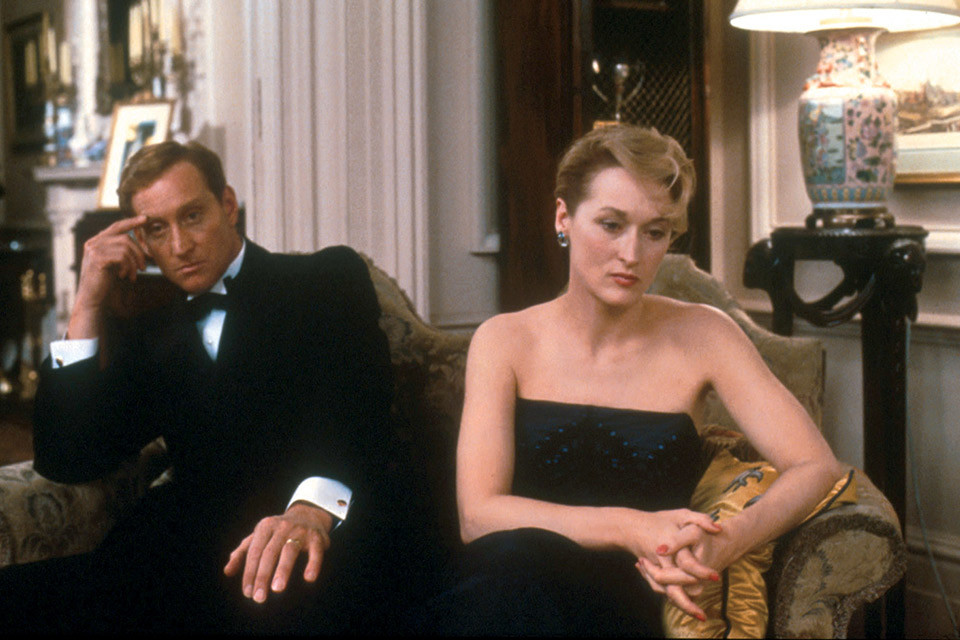
Plenty
Plenty, also directed by Schepisi, stars Streep as Susan Traherne, a woman who fought in the French resistance, and is unable to “find herself” in postwar England. This is her most feminist, or pseudo-feminist role, as an upper-middle-class woman who, in a series of disconnected episodes, lives life in a mounting rage. It’s also one of Streep’s most difficult and ambiguous roles, in that we’re never allowed to get a hold on this alienated and alienating creature: she’s lost, cruel, lashing out in her anger, but why and about what? Sometimes about England and colonialism, sometimes about men and their uselessness. But mostly about her giant disappointment in a life that has failed to live up to the peak moments of her wartime experience. Kate Nelligan at the Public Theater made Susan Traherne seem, if not consistent, believably (or at least pathologically and emotionally) inconsistent. Something to do with her tight-wound ferocity and jangled nerves, a woman perpetually in attack mode. Streep is too placid and even charming for such a conception, but maybe it’s her phlegmatic good-girl reserve that gives such shocking splendor to the scenes in which she does behave outrageously.
When she approaches Sting, the lower-class bloke she hopes will father a child for her, “marriage not involved,” she talks about not needing men. “I’m quite strong minded with men. I’m holding myself in for fear of blowing them out of the room.” And there’s a sudden hush of fear and suspense, exactly what she inspires in those men who don’t know what to expect. “Deep down that can’t be what you want,” he tells her, and she chillingly replies, “Deep down I’d do the whole thing myself, you’re second best.”
Shortly thereafter, married now to Charles Dance’s mid-level diplomat, comes one of the most terrifying and exhilarating scenes of Streep’s career, when she erupts into a paroxysm of Bad Behavior at her own posh and professionally important dinner party. This is real horror—when a perfectly charming, perfectly lovely person loses it, and loses it in a perfectly lovely way. The fabric of polite society is ripped and bloodied, a roomful of diplomats and their wives left gaping, the evening smashed to smithereens, because a well-dressed hostess launches on a tirade about a taboo subject in front of the Foreign Secretary (a glorious John Gielgud). “The words ‘Suez Canal’ will not be spoken,” Susan tells him, and then in the quietest way, will not shut up. Never mind that Gielgud reassures the husband that “a mad wife is almost a guarantee of promotion,” the man’s career is over. Come to think of it, there’s a little sub-theme in Streep’s movies of sabotaging a husband’s career, from the firing of Kramer, the frenetic parent who can no longer give full attention to his job, to the decline of Sam Neill’s pastor to the Siberia-izing of Charles Dance’s diplomat. If only she could have done the same to Jack Nicholson’s treacherous reporter-husband in Heartburn (86). Okay, so her Rachel Samstat (aka Nora Ephron) walks away from the scoundrel, children in tow, after smashing a homemade pie in his face, but the lack of a more satisfying revenge may be precisely what makes the soufflé flop (or the key lime pie curdle), why this comedy leaves us with a sense of letdown and a heroine’s diminishment.
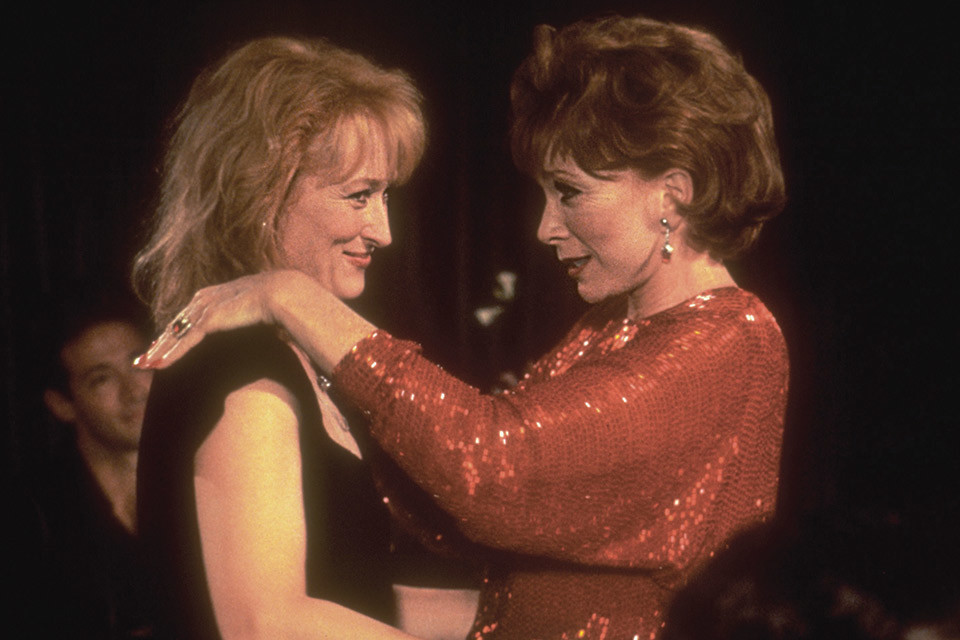
Postcards from the Edge
A Nichols-Streep movie with a more triumphalist flavor was Postcards from the Edge, the adaptation of Carrie Fisher’s wickedly funny Hollywood-meltdown novel/memoir. The fraught, lovely relationship between Streep’s bad-girl actress and Gene Hackman’s director is just one of the gems of a movie in which Streep sends up her persona (playing a cop, she’s told to lighten up, have more fun). Yes, the movie’s a formulaic fairy tale about the rehabilitation of a poor little pharmacopia-fed rich-girl movie star, and it’s extravagantly showbizzy (some of the criticisms leveled against it), but Nichols’s knack for doing mainstream movies with an edge gives freshness and bite to familiar themes, like the juicy relationship between mother and daughter.
Another director who handled her expertly and empathically was Sidney Pollack in Out of Africa (85), where he shrewdly kept her Karen Blixen in the middle distance, avoiding close-ups—those intrinsic bids for sympathy—providing a sort of cocoon of privacy, allowing Streep to feel her way through the gradations of a personality who was unusually complex even for an actress who thrives on contradictions. Both bossy and insecure, she strikes me as perfectly capturing a certain well-born type of European woman, a mix of enlightened liberalism and prudishness; patronizing noblesse oblige and vulnerability. Early on, left behind by husband Klaus-Maria Brandauer, she makes it clear that she yearns for the man’s life of action, envying them the ability “go off to be tested” whereas a woman’s test is “how well we can endure loneliness.” It turns out she’s better at passing men’s tests than women’s, as she rides off into the bush where a dangerous battle is underway. That’s her bravery and her foolishness. She wants to be independent but appreciated, wants the English community “to like me but I want to be left alone, too.” The paradox of the movie star. Robert Redford as Dennis Finch-Hatton, is every thinking woman’s fantasy (which is more erotic? The eyes locking for the first time at the club Christmas ball or the hair-washing scene in the bush?), the intuitive one, while she’s the one who needs to reason everything out, to control life. It’s to Streep’s credit that she makes us feel for this desperately rational woman who’s afraid of feeling, and who finally can’t live up to her own resolutions, when the heart cannot be denied, and she risks losing Dennis by commanding him not to go flying with a woman friend. Nothing (unless it’s her reading of the poem at the burial site) is more moving than her utter silence after learning of his death, and the way we observe her courage by being kept at a discreet and respectful distance.
Some critics have reproached her for not taking risks, small parts, the way Julianne Moore has done. It may be she became a star too quickly, having created a buzz even before she left Yale Drama School, so that it became difficult to take the smaller parts that might have allowed her to develop away from the spotlight. Yet it’s hard to argue with such a career; and one that promises such varieties this year and next as Mamma Mia!, Martha Mitchell in Dirty Tricks, and Julia Child in Nora Ephron’s Julie and Julia.
Adaptation
Lately, in Redemption (as a CIA official of frightening authority) and The Manchurian Candidate, she’s played political women on the cutting edge. Together, she and Jonathan Demme found a way to channel Hillary into the seethingly ambitious mother originally played by Angela Lansbury. There are scenes right out of the Hillary playbook where she not only captures the harsh ugly side of this super-competitive politician, her impatience with fools, the sense that she has the God-given right to wipe out her adversaries, but also specific mannerisms and gestures. She’s a great mimic (does anyone besides me see and hear Pauline Kael, round glasses, flying hair and a bent-forward breathless intensity, in the shrink in Prime?) She has to know firsthand, too, the ambivalence that Hillary has provoked among the body politic toward a certain kind of powerful woman—those who are too attractive to be relegated, Abzug- and Friedan-like, to a category of the not-really-feminine political animal; yet are not babes enough to use seduction to deflect attention from their minds and reassure the world that they’re “just women” after all.
Yet for an actress who’s made of sterner stuff than mere sexiness, who’s miles from being a dumb blonde or a love object, Streep has enjoyed fabulous erotic encounters with some of the hottest co-stars on the planet: with Kevin Kline, Kurt Russell, Sam Neill (early and late scenes in Plenty), Dennis Quaid, Robert Redford, Klaus Maria Brandauer, and Clint Eastwood (I can still feel the breath-held silences). The list is literally and figuratively breathtaking, and sometimes what makes the relationships so exciting is the contrast between her stiffness or reserve or braininess, as against their easygoing virility. Or the fact that, like Clint Eastwood, they never “do” romance. And even in the less erotic pairings, there’s plenty going on: the scenes in bed with Nicholson in Heartburn, eating pasta at four in the morning or listening to him sing “My Boy Bill,” are, if not particularly sensual, cuddlesome fun, lovely moments of felt congeniality. The rapport between “Susan Orlean” and Chris Cooper’s orchid thief in Adaptation (02), likewise with Albert Brooks as her suitor in the afterlife in Defending Your Life (90), are of another stranger order, self-conscious conceits by writer-directors with which she gamely goes along.
We know she likes to sing, she’s been doing musical numbers all along. In the recent avant-garde short The Music of Regret (06), by filmmaker-photographer Laurie Simmons, Streep in preposterous deadpan plays funny-charming love duets with a series of Howdy Doody-like puppets.
The music of regret might be one theme song that hovers over her films. So many things have happened in the past, so many unfulfilled hopes raised. And despite, or perhaps because of, the excitement or expectation of her love scenes, there’s always a sense of impermanence in which she allows us to feel her essential aloneness. Whether seeking the “passion” of the orchid thief, or looking back to the perfect moment of a Cape Cod morning, or emulating the life of action, she’s yearning for the return of those peak experiences, anxious for her life to assume importance and intensity. But Streep’s greatness as a performer is to let us in on the hollowness of this desire, while at the same time, in showing us how to endure loneliness, she make us feel less alone.







